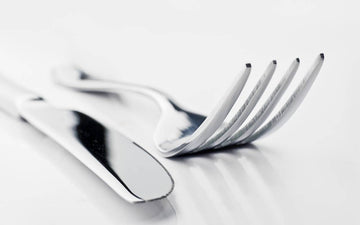
A supreme knowledge of chess tactics is what separates a good chess player from a great one. Learning to effectively use the fork is also when most players transition into the intermediate level. Basically, it is a tactic where one piece attacks two or more pieces simultaneously. The English proverb, "hitting two birds with one stone" or it's Hindi translation, "एक तीर से दो निशान" sums it up perfectly. It is clear why one would name this tactic 'fork'. It is a comparison to the prongs of a fork that (attack) pierce the food.
Ofcourse there are different kinds of forks possible with different pieces. We'll look at each one of them in great detail. The underlying strategy among all these is that a piece of lower value attacks two pieces of equal (and) or higher value. If this is not true, it may still be feasible if the sacrifice would lead to a definite strategic stronghold.
1. Knight Chess Fork Formation
As a chess enthusiast, I really like playing with my Knight because of its ability to jump over other pieces. Forming the fork using the Knight is very interesting and perhaps the most rewarding. This is because, it is impossible to block a Knight's check without capturing the Knight or moving the King out of the check.

The gif above illustrates a fork by the Knight. In this case, the black pawn threatens to be promoted with the help of the Rook. Thus, a sacrifice is made by the white Rook to ultimately gain a strategic advantage.
To learn more about the Knight in chess, check out our article here:
2. Rook Chess Fork Formation
The Rook is one of the most powerful pieces in the game. Worth 5 points, it can attack any chess piece of the enemy placed in the same horizontal line or vertical line. To form a fork through the Rook, you just need to develop your Rook to a position where it is directly between two enemy chess pieces either in the same row or column or in intersecting rows and columns.

In the gif above, the Rook is moved to the other end of the board forcing a check and ultimately forking the King and the Black Bishop. At this stage, Black has no choice but to move the King away, giving away the Black Bishop.
To learn more about the Rook in chess, read our article here:
3. Queen Chess Fork Formation
The Queen is the most powerful piece on the chess board. Naturally, the Queen has an innate ability of forming a fork. This is because of the Queen's versatility to move across the board. While easy to strategize, forks often end up attacking two pieces. The opponent may have the option of capturing your Queen despite employing this tactic. For this reason, the Queen is rarely used in this tactic, unless it is obvious that the pieces being attacked cannot capture the Queen.
In the gif below, we can see that the Queen goes ahead to give a check while attacking the dark square black bishop. The Bishop in this case is neither able to block the check nor defend itself resulting in its capture.

To know more about the Queen in chess, check out our article here:
4. Pawn Chess Fork Formation
Pawns are the least valued piece in the game of chess. But they are possibly the best pieces to execute a fork aimed at capturing the opponents pieces. This is because, even if the opponent manages to capture the pawn using a major piece, you still gain material advantage and level up. The collateral damage in a fork formed by the Pawn is the least of all the other formations. So, it is very important to have a sound pawn structure to enable such tactics.

As we see above, the pawn is moved forward to attack the bishop as well as the Knight. Even if captured, the collateral damage to White is a lot lesser. It is often that players prefer giving up their bishop as opposed to their Knight.
Do read our article on Basic Pawn structure and it's importance in the game:
5. Bishop Chess Fork Formation
Bishops are pieces in the game that can only move diagonally across the board. However, their unrestricted range of movement makes them good candidates to form a fork. They are most dangerous when placed in the center of the board. This is because they are looking for an opportunity to attack both sides of the board.

In the depiction above, the Bishop known for its ability to take the opponent by surprise, creates a fork by capturing the pawn on c5 to give a check and attack the black Rook.
To learn more about the Bishop, check out our article here:
6. King Chess Fork Formation
Eventhough the King can only move one square at a time, it can still deliver the fork. To accomplish this, it needs to be in a position such that the opponent pieces being attacked do not threaten a check. It is a rare occurrence and that ways, your opponent won't even see it coming! Using the King to attack your opponent pieces is an extremely effective strategy in the endgame.

The Black knight here gives a check to the White king, but it does not realise that it has only created a great chance for white to capture one of its major pieces.
Interested to know more about the King in chess? Check out our article below to learn more:




